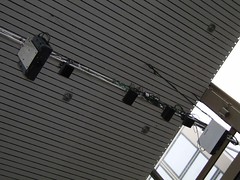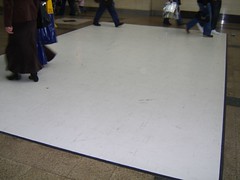I have also been asked to be a visiting lecturer next semester. This has been interesting challenge for me because it has allowed me to re-think my way into publishing and the public sphere at a time that the industry (industries?) appears to be moving through another re-structuring (for example – the changes facilitated by print-on-demand, blogging, google ad sense and the changing landscape of advertising). It has also been a chance to re-visit some authors that I did not have time for during my PhD (the reading list for this course includes Pierre Bourdieu and Gerard Genette) which is nice for me because (strange though it may sound) I am rather fond of theory (I wonder whether my students will share my passion).
Perhaps the most influential contact with my colleagues so far has come through the New Media Reading Group. My colleagues in this group have been working on a text which has the provisional title of ‘Architectures of Participation’. This project began before I joined the group; however, the work done by the group has been quite helpful for me because it has brought together a number of strands that point to the importance of the concept of participation to current thinking. For example, I had observed (and experienced) an historical trend over the last thirty years or so to encourage ‘participation’ in art. I am thinking, in particular, of claims for conceptual art, mail art and net.art (to lay out a problematic pathway through the maze of recent art histories). I find the contemporary claims for these practices particularly interesting because they provide some interesting insights into the relationship between art, activism and communities. However, I am also interested in the role played by the concept of participation in the aesthetics of video games (and other ‘new media’ art forms). Espen Aarseth, for example, makes a number of interesting claims for games in his notion of the ergodic. The term ‘participation’ is also hot at the moment because it is an important ‘selling’ feature for the appropriation of user-generated content by companies such as YouTube. Arguably, the most extreme position in this ‘interested in participation’ spectrum goes to Jonathan Schwartz, the COO of Sun Systems, who has claimed that we are now living in the ‘Age of Participation’. Maybe, he is right to flag up the importance of the concept even though he does not really explain how the current use of participation is different form the past!
I freely admit that the concept of participation also makes a guest appearance in my PhD work; mainly through my appropriation of Mikhail Bakhtin’s understanding of the reader’s participation in the act of meaning-making.
I can’t help feeling that the notion of participation is rather under-theorized at present (by me as well as by everyone else). It might help to try and take a systematic approach to our understanding of its aesthetic, cultural and political meanings; to try and get pass the claim that it is something obvious, inherently desirable or unique to the current generation of web services; and to think further about its relationship to similar terms such as collaboration and hegemony.
Participation might well turn out to be a multiple concept as I find it hard, at present, to relate Bakhtin’s notion of ubiquitous participation in all acts of meaning-making with the use of participation as a ‘call to action’, by both activist artists and corporations keen to get us off our cultural backsides.
This work on participation is, of course, a much wider project than the one that I am currently embarked upon, so it will have to wait. However, I believe that it might make an interesting study in its own right. For the present, however, I am hoping to contribute a chapter to the book that re-evaluates some of the experiences described by artists adopting ‘participation’ into their practices in order to provide an insight into some of the issues of power and control surrounding participation and the promotion of user-generated content by corporations.
It sounds to me that I might well be busy over the coming year!




